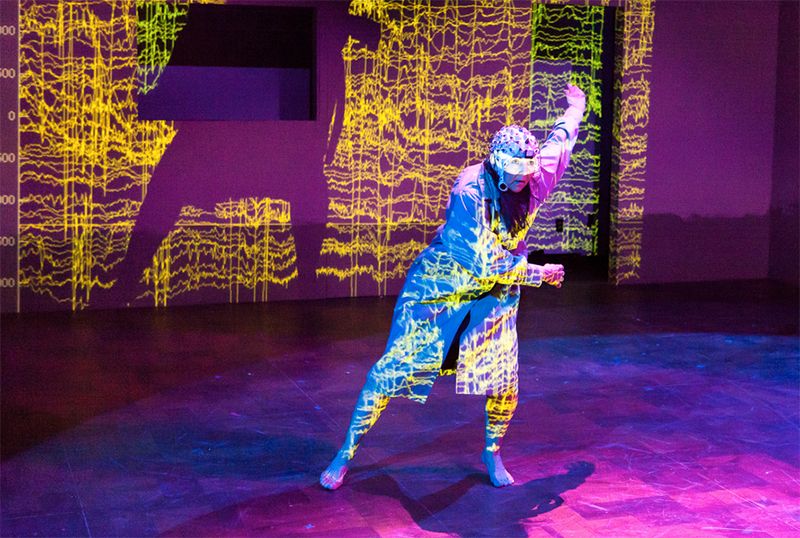This Exoskeleton Is Actually Controlled by the Wearer’s Thoughts
Engineer Jose Contreras-Vidal’s “brain-machine interface” uses electrical activity in a person’s brain to move a robotic exoskeleton
:focal(891x205:892x206)/https://tf-cmsv2-smithsonianmag-media.s3.amazonaws.com/filer/58/0f/580fe7d0-6b15-4c6a-a8ce-5b481d4029f9/steve-rex-braincap1-ecd475c908af8b9f961d6a4b6a073de2ca3630c7.jpg)
University of Houston engineer Jose Contreras-Vidal does some futuristic, stranger-than-science-fiction research. He’s developed a “brain-machine interface” to interpret brain signals and turn them into movement. With this interface, he has created a bionic hand and a computer avatar that are controlled by the user's mind.
But the centerpiece of his work is a thought-controlled exoskeleton to help paralyzed people walk. For the past several years, Contreras-Vidal has been working with the REX lower body exoskeleton, developed by New Zealand-based REX Bionics. The exoskeleton is made to be controlled with a joystick. But Contreras-Vidal and his team have retrofitted a version to be used with their brain-machine interface. The user of the exoskeleton wears an electrode cap, with sensors on the scalp that read electrical activity in the brain. An algorithm developed by Contreras-Vidal and his team “interprets” the brain information and translates it into movement of the exoskeleton. In other words, the wearer thinks “move, left knee,” and the algorithm turns it into action. This can create relatively quick movements, as even in non-injured people it takes a split second for information to travel from the brain to the body.
“Any time we plan a movement, the information is there before we’re actually seeing the movement,” Contreras-Vidal says.
A number of researchers over the years have helped paralyzed people move using electrodes implanted in their brains. Contreras-Vidal’s patent-pending system is different because it is noninvasive—users take the electrode cap on and off at will. This is particularly useful in the case of patients who will only need the exoskeleton temporarily, such as stroke victims who might use the exoskeleton to regain walking ability, then learn to walk unaided. (A Brazilian-led team developed a noninvasive brain-controlled exoskeleton to allow a paraplegic to kick off the 2014 World Cup; the suit, however, didn't allow the user to walk unaided).
The thought-controlled exoskeleton is the result of years of work on decoding the language of the brain. At the University of Houston, Contreras-Vidal directs the Laboratory for Non-invasive Brain-Machine Interface Systems, which employs a team of engineers, neuroscientists, doctors, computer experts and even artists. Before Houston, he directed the Laboratory of Neural Engineering and Smart Prosthetics at the University of Maryland, where he worked on developing brain-controlled prosthetics for amputees. The algorithms used to translate thoughts into movement are constantly being improved, Contreras-Vidal says, in what he describes as a "creative process."
Right now, his lab is working on several projects using the brain-machine interface. One project looks at neuro-motor development in children using the electrode cap; the team hopes a better understanding of this process may eventually help children with neurological developmental disorders, such as autism. Another seeks to understand what happens in the brain when people experience art, fitting museum-goers with an electrode cap as they look at an art installation.
The brain-controlled exoskeleton is currently undergoing trials. It's already been used in a number of real-life scenarios; a British quadriplegic man recently walked using the exoskeleton at a conference in Italy.
Contreras-Vidal and several of his students will be demonstrating the exoskeleton at the Smithsonian’s upcoming Innovation Festival. The festival, a collaboration between the Smithsonian Institution and the U.S. Patent and Trademark Office, is happening September 26 and 27 at the National Museum of American History.
“We’re very excited about going to the Smithsonian, because I think scientists need to talk to the public, particularly to children,” Contreras-Vidal says. “They need to be exposed to this type of technology to see it’s really about creating and innovating.”
As if the robot-like exoskeleton is not impressive enough for kids and other festival-goers, Contreras-Vidal and his team will allow visitors to view their own brainwaves on a screen by donning electrode caps. Contreras-Vidal describes tuning into a person’s brainwaves as “listening to the neurosymphony.”
“I like to see the brain as a symphony, where all the major areas are part of the ensemble and each player in this ensemble is responsible for some aspect of their behavior,” he says. “To play this music they need to coordinate.”

The overlap of art and science is an important part of Contreras-Vidal's work. In the past, he's wired up artists to peer into their brains' creative processes. More recently he's been working with dancers. In a project called Your Brain on Dance, he's fitted dancers with electrode caps and displayed the resulting brain waves on a screen as they perform. He believes that ultimately this kind of inquiry into the neural basis of movement could lead to a new understanding of Parkinson's and other brain diseases.
At the Innovation Festival, visitors will be treated to such a dance performance.
“Scientists can learn a lot from art and vice versa,” Contreras-Vidal says. “I’m hoping that this will capture the imagination of people, children especially.”
The Innovation Festival will be held at the National Museum of American History on September 26 and 27, between 10 a.m. and 5 p.m. The event, organized by the Smithsonian Institution and the U.S. Patent and Trademark Office, will feature examples of American ingenuity developed by independent inventors, academic institutions, corporations and government agencies.
/https://tf-cmsv2-smithsonianmag-media.s3.amazonaws.com/accounts/headshot/matchar.png)


/https://tf-cmsv2-smithsonianmag-media.s3.amazonaws.com/accounts/headshot/matchar.png)